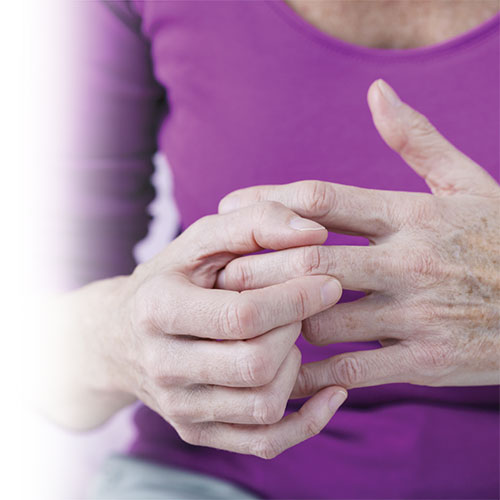Arthritis and osteoarthritis are two different conditions, which patients very often get mixed up. Find out how to tell them apart.
Arthritis: too often a loosely used term
It can sometimes be difficult to understand the various medical terms describing joint pain. The term “arthritis” is a generic term that groups together roughly 100 different joint diseases. The common denominator for these diseases is joint pain. Swelling, redness and loss of mobility can also be part of the overall picture.
In layman’s terms, many people use the term “arthritis” in reference to two diseases in particular: osteoarthritis and rheumatoid arthritis. Yet, these are different disorders. Other diseases are part of the broad category of arthritic disorders, including psoriatic arthritis, ankylosing spondylitis and Paget’s disease.
Osteoarthritis: THEE most common type of arthritis
Who hasn’t heard someone say “I have arthritis” when that person seems quite healthy? Osteoarthritis is often closely related to aging. It is the result of a gradual deterioration of the joints due to various factors, including age, repetitive joint movement, a past injury or obesity.
People who suffer from osteoarthritis are often bothered by joint pain and stiffness. Deformity of the affected joint can sometimes be observed.
How does osteoarthritis develop?
Osteoarthritis is a degenerative disease of the articular cartilage in the joint (smooth, strong and elastic tissue that covers the extremity of bones which form the joint, acting as a shock absorber). Individuals will experience damage to some of their joints over the course of their lifetime.
In the case of osteoarthritis, cartilage is damaged and slowly wears away; the bare bone is then exposed to friction, which over time, contributes to damage and causes pain, discomfort and stiffness. Several joints may be affected by osteoarthritis, including those of the hands, spinal column, hips and knees.
Osteoarthritis is a common health problem in people aged 60 years and older; but it is not a serious condition. However, it may have a significant impact on quality of life.
How do I know if I have osteoarthritis?
It is always necessary to be diagnosed by a doctor. However, you may suffer from osteoarthritis if you are in the following categories:
- You are over 50 years of age.
- You have a family history of osteoarthritis.
- You experience discomfort or pain in one or several joints.
- You have stiff joints, especially when you wake up in the morning.
- You have reduced joint mobility.
- You notice joint deformity or swelling.
- One or several joints tend to “lock”.
- You hear a cracking sound when you move the joint.
- Rest relieves joint-related symptoms.
- Your general health is good aside from joint-related symptoms.
Other types of arthritis
Aside from osteoarthritis, it can be said that other types of arthritis have one common characteristic: joint inflammation. The inflammation process may be due to several different factors such as infection, biochemical imbalance or genetic defect. In the case of rheumatoid arthritis, inflammation is due to an immune system imbalance which, to a certain extent, attacks one or more joints.
It isn’t unusual for an individual with a type of arthritis that is not osteoarthritis to have other symptoms than just the affected joints, such as fatigue, fever, general malaise, loss of appetite, etc. Sometimes, nerves and organs (especially the heart or lungs) may be affected.
Arthritis may also accompany another type of disease, for example, psoriatic arthritis affects certain individuals who have psoriasis (a skin disease).
Tips on how to relieve joint pain
If you suffer from joint pain, here are a few tips:
- First, be sure to get a medical diagnosis.
- Learn to recognize your limits and when to rest. Some activities may worsen your symptoms, especially if you have osteoarthritis.
- Exercise, but stick to what you are able to do. Being completely inactive may worsen the problem.
- Lose excess weight so you don’t put stress on your joints.
- Don’t suffer from pain. But always ask your pharmacist or doctor for guidance before taking medication to relieve arthritis pain.
Don't hesitate to speak to your pharmacist for additional information on the different types of arthritis, joint pain or available treatments.


